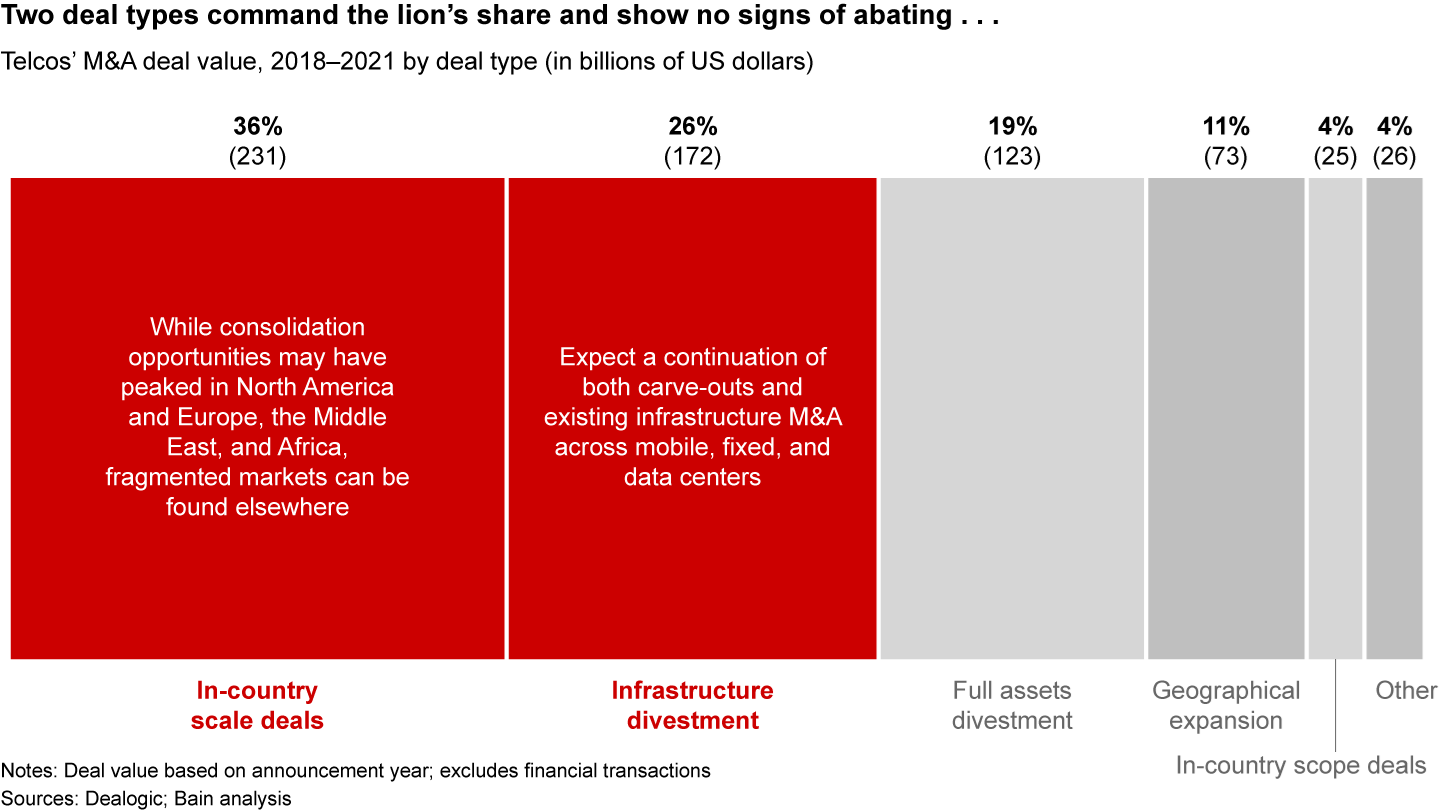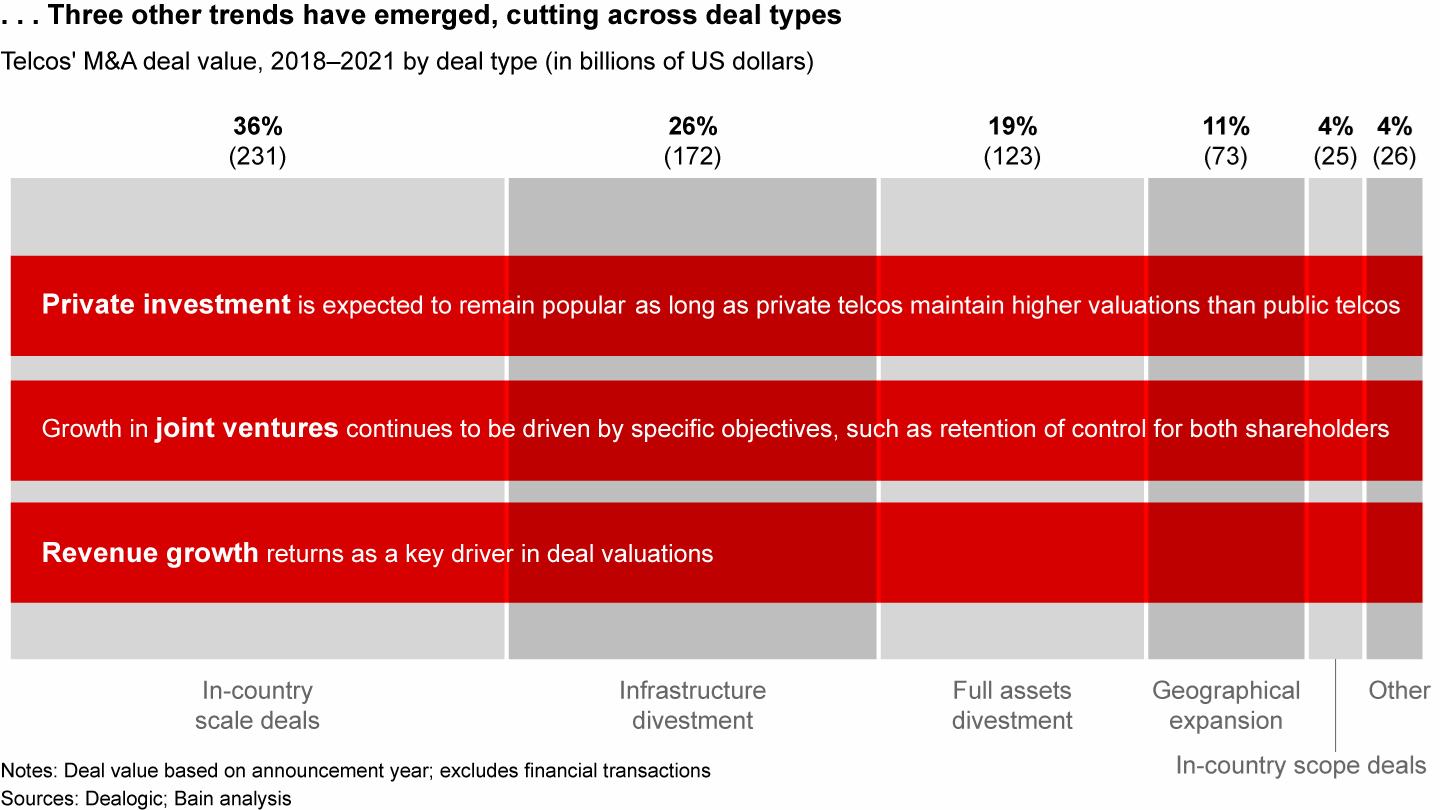M&A Report

At a Glance
- M&A in the telecommunications industry rebounded dramatically in 2021, with deal value rising by 48% and record-high multiples reported across most subsectors. Fully 56% of deal value was realized by either in-country consolidations or infrastructure deals.
- Private investments also grew in 2021, by 100%, with private investment multiples rising faster than public trading multiples. Private investment momentum will continue for as long as private telco valuations stay significantly higher than listed telco valuations.
- Amid high valuations, more companies are devising new ways to structure joint ventures (JVs): Some engage in scale deals in which no company wants to relinquish control; others capture cost synergies by consolidating networks while still retaining their independence at the retail level.
This article is part of Bain's 2022 M&A Report.
The year 2021 helped us clearly see the telecommunications industry’s resilience. While the economic uncertainty created by the Covid-19 pandemic caused M&A activity to decline in early 2020, the new year brought with it a resurgence, with deal value growing by 48% and record-high multiples across most subsectors.
The 2021 telecom M&A activity reflects five longer-term underlying industry trends that have been building over the past three to five years, as well as some emerging themes resulting from the accelerated transformation caused by the pandemic (see Figure 1).
Five key themes in telecom M&A


Five key themes in telecom M&A


Scale deals. Scale deals, such as in-country consolidation, continued to make up the bulk of telecom M&A. Operators hoping to advance their markets to their end state are consolidating before competitors beat them to it. Consider Rogers Communications’ $21 billion acquisition of Shaw Communications in Canada in March and the $2.2 billion Indosat-Hutchison deal in Indonesia.
Infrastructure deals. Infrastructure M&A, particularly in tower and fiber assets, is skyrocketing as companies and private investors are eager to join the infrastructure party while the music still is playing. Multiples for infrastructure transactions reached 18 times in 2021, up from an average of 14 times in 2020. By comparison, multiples for integrated operator acquisitions averaged 9 times. Among the notable infrastructure deals of 2021, we have American Tower’s $9.4 billion purchase of Telxius and the $1.3 billion CDC-Orange deal for French fiber assets. Infrastructure assets have proven particularly robust and offer a clear path to revenue growth. Additionally, many operators face balance sheet and rating constraints as they accelerate the build-out of new networks, making off-balance sheet joint ventures (JVs) with private investors an attractive alternative to self-funding.
Multiples for infrastructure transactions reached 18 times in 2021, up from an average of 14 times in 2020.
Private investments. Private investors maintained their growing interest in telecommunications across all deal types. Fueled by higher transaction multiples for private transactions than public trading, the total value of their investments in the industry reached $79 billion in 2021 from $39 billion in 2020, and now consistently constitutes 29% to 39% of total deal value, up from around 5% prior to 2019. In one such deal, French billionaire Xavier Niel, controlling shareholder and founder of iliad, bid €3.1 billion to take the company private. In another, global private equity firms Apax Funds and Warburg Pincus agreed to buy T-Mobile Netherlands from Deutsche Telekom for €5.1 billion. And finally, private equity firm KKR in November announced a takeover bid for Italian incumbent telco TIM for €10.8 billion. As they see this trend escalating, operators are rethinking their portfolios with an eye toward divesting underperforming and noncore assets.
Joint ventures. Alternative deal structures accelerated substantially in 2021. To meet specific objectives, more companies are turning to different flavors of JVs rather than pursuing traditional M&A.
Companies are participating in joint ventures for scale deals in which neither shareholder wants to relinquish control. In September, Chile’s VTR and Claro struck a JV that the companies anticipate will generate synergies of $180 million. Partial scale JVs help telcos capture significant cost synergies by consolidating networks while still retaining their independence at the retail level. Another variant involves using JVs between telcos and private investors to carve out existing infrastructure assets or to build new infrastructure, mostly for funding or balance sheet considerations.
Companies are participating in joint ventures for scale deals in which neither shareholder wants to relinquish control.
Revenue takes a front seat. In 2021, revenue growth returned as a key driver in deal valuations. In scale deals, revenue synergies (fixed-mobile synergies) through cross-selling to different products’ customer bases add to cost synergies. Revenue synergies also are baked into the investment theses of deals in which private equity companies acquire growth challenger telcos, for example. And increasingly, a clear path to top-line growth is becoming a requirement for infrastructure JVs, too.
What’s ahead?
Here’s how these M&A trends and themes will prevail in 2022 and beyond.
Scale deals will continue in the still fragmented and less strictly regulated markets of Latin America and Asia-Pacific and potentially reemerge in Europe, depending on regulatory changes. But mobile/fixed-mobile consolidations will gradually decline in Europe, where companies have already taken advantage of most opportunities. One potential hot new area for scale acquisitions is in maturing fiber alternative network, or “altnet,” assets as we expect more activity in the horizontal and vertical integrations of newly created fiber-to-the-home altnets and JVs.
Infrastructure deals will continue to be propelled by high demand, with high valuations and high supply. Similarly, we anticipate a continuation of both carve-outs and existing infrastructure M&A across mobile, fixed, and data centers.
While the decline in interest rates has contributed to the rise in infrastructure investments, stable or even further declining interest rates would likely result in a selloff of infrastructure investors’ stakes to other types of investors.
Perhaps most important, we predict a wave of fiber altnet consolidation reminiscent of the cable roll-ups that were popular two decades ago. The contributing factors are in place: There’s abundant capital, overbuild situations, and incumbents pursuing accelerated growth. All of that, combined with the alternative scenario of possible inflation and higher interest rates, could provide the catalyst for accelerated fiber altnet consolidation.
Private investments will maintain momentum for as long as private telco valuations stay significantly higher than public (listed) telco valuations. For example, there are challengers looking for growth and margin expansion by moving wholesale-based businesses onto their own infrastructure.
Private investors will show interest in telcos in other ways: In some situations, controlling shareholders will act on the belief that there is higher value in private telecom investments than in capital markets. Private investors will go after stranded assets within telcos’ portfolios. Finally, private investors will show interest in incumbents with strong, still-integrated infrastructure assets and little overbuild risk.
JV deals will also be a popular choice for as long as the wide gap between private and public valuations remains, regulators maintain their stance of opposing full-scale consolidation of markets, and the current infrastructure dynamics continue.
Revenue growth and synergies will also continue to be a theme in the years ahead, justifying high valuations. In a recent survey of telecom M&A executives, a revenue synergies assessment was ranked highest in importance among 10 due diligence elements, with 50% of the respondents predicting that revenue synergies would be significantly more important or somewhat more important in the future.
In a recent survey of telecom M&A executives, a revenue synergies assessment was ranked highest in importance among 10 due diligence elements.
Five basic questions for telecom players
In 2022 and beyond, telcos need to develop new strategies and capabilities to take advantage of rising M&A opportunities, chances to partner, and possibilities to divest selected portfolio assets. For many, the decision about when to participate, where to participate, and how to participate will come down to answering versions of these five fundamental questions:
- Will we actively drive our markets to end-state structure, or will we allow others to do it to us?
- Are we joining the infrastructure party while the music still plays?
- Is now the time to rethink our portfolio and consider divesting underperforming and noncore assets—or partial assets?
- Which of our markets, infrastructures, and capabilities could lend itself to a JV approach as opposed to traditional M&A?
- Have we discounted revenue synergies and growth too much in our M&A considerations?